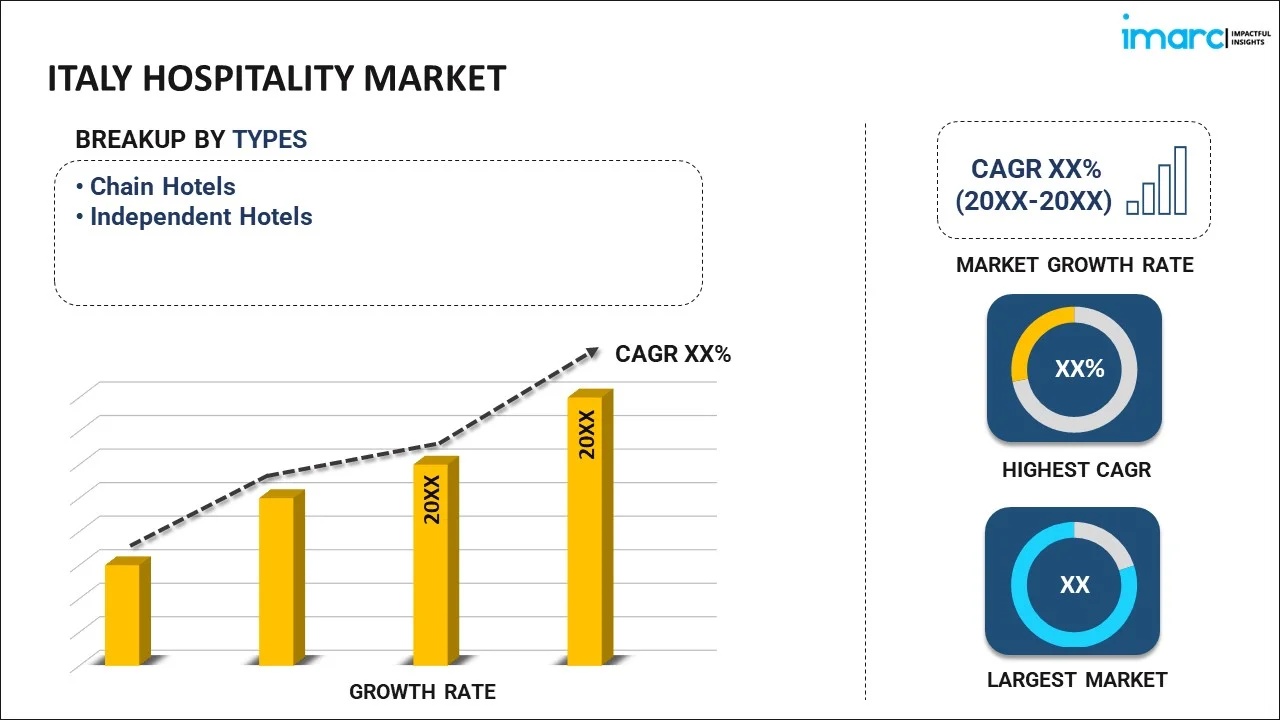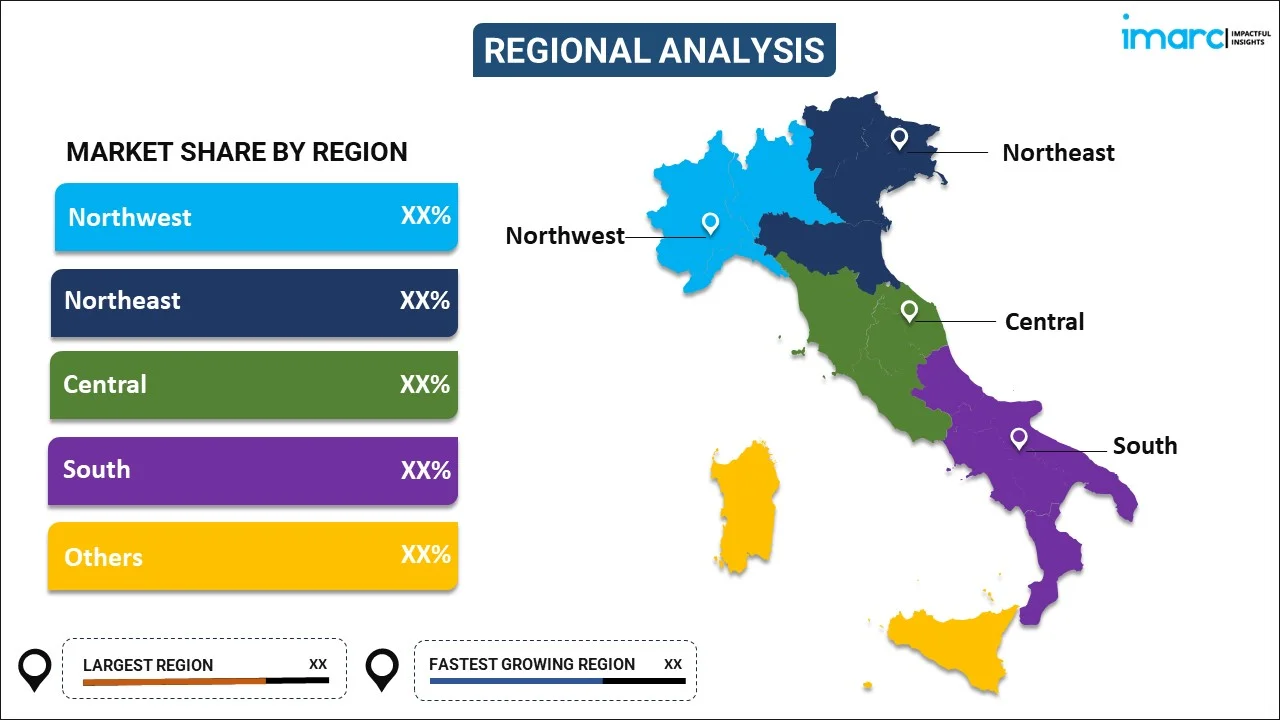
Italy Hospitality Market Report by Type (Chain Hotels, Independent Hotels), Segment (Service Apartments, Budget and Economy Hotels, Mid and Upper Mid-scale Hotels, Luxury Hotels), and Region 2025-2033
Italy Hospitality Market Overview:
The Italy hospitality market size reached USD 9,600.3 Million in 2024. Looking forward, IMARC Group expects the market to reach USD 11,473.3 Million by 2033, exhibiting a growth rate (CAGR) of 2% during 2025-2033. The market is experiencing significant growth mainly driven by sustainable tourism, luxury experiences and rich cultural heritage. Increasing technological integration, along with the rising focus on health and wellness is enhancing guest experiences, thereby driving the market growth.
|
Report Attribute
|
Key Statistics
|
|---|---|
|
Base Year
|
2024 |
|
Forecast Years
|
2025-2033
|
|
Historical Years
|
2019-2024
|
| Market Size in 2024 | USD 9,600.3 Million |
| Market Forecast in 2033 | USD 11,473.3 Million |
| Market Growth Rate (2025-2033) | 2% |
Italy Hospitality Market Trends:
Rise in Culinary Tourism
Culinary tourism in Italy is thriving as visitors flock to experience its famous cuisine firsthand. The hospitality sector is leveraging its interest by diversifying its offerings. Cooking classes are particularly popular allowing tourists to learn how to prepare traditional dishes under the guidance of local chefs. Food and wine tours are another highlight offering immersive journeys through Italy’s diverse culinary landscapes from vineyards of Tuscany to the truffle-rich forests of Piedmont. According to an article published by the Olive Oil Times, in 2023, 58% of Italian tourists prioritize food experiences a 37% increase from 2016. Olive Millers and farmhouses benefit from this trend 64% of tourists planning olive oil-related experiences. The 2023 Wine and Food Tourism Report, based on the input of over 320,000 tourists, indicates an increased interest in food and wine tourism. 71% of tourists are interested in healthy food and the Mediterranean diet. In line with this, the farm-to-table movement has gained momentum, with many establishments sourcing ingredients directly from local producers to create authentic, regional meals. This approach not only enhances the dining experience but also supports the local economy and promotes sustainable practices.
Rising Prevalence of Sustainable Tourism
Sustainable tourism in Italy is gaining traction as the sector Increasingly prioritizes ecofriendly practices to minimize its environmental footprint. This shift is evident in growing number of accommodations and tourist services integrating sustainability into their operations. Many hotels and resorts nowadays are adopting renewable energy resources like solar and wind power to reduce their reliance on nonrenewable sources. Waste reduction strategies are also widespread with initiatives aims at composting, recycling and reducing single use plastics across the tourism sector. For instance, in 2023, the Italian luxury hotel collection VRetreats, part of VOIhotels achieved global Sustainable Tourism Council at four properties. These efforts include eliminating plastic use, providing zero-kilometer menus, utilization of renewable energy, supporting reforestation, providing water to communities in need and introducing sustainable uniform shoes for employees. The hotels are committed to protecting the environment and supporting the social and economic development of their areas. Furthermore, there is a significant movement towards the use of local and organic food products. This not only lowers the carbon emissions associated with food transport but also supports local agriculture and provides tourists with fresher, healthier food options.
Italy Hospitality Market News:
- In October 2023, Accor expanded its presence in Italy by adding the historic Grand Hotel della Posta in Sondrio to its Handwritten Collection brand. The hotel will undergo refurbishment and offer 38 rooms, a restaurant, a café, meeting rooms, a spa, and a fitness center. This move aligns with Accor's focus on sustainability and repurposing existing structures. The Handwritten Collection aims to bring unique, owner-driven establishments to guests. The brand also has upcoming projects in Spain and France.
- In May 2023, IHG Hotels & Resorts unveiled the InterContinental Rome Ambasciatori Palace, a luxurious addition to its portfolio in Rome. The hotel offers 160 neo-classical rooms and suites, reflecting Italian design and craftsmanship. Culinary experiences include Scarpetta NYC and Charlie's Rooftop, with a New York-style cocktail menu. Embodying discreet luxury, the hotel's prime location near iconic landmarks makes it an ideal base for travelers exploring Rome's rich history and culture.
Italy Hospitality Market Segmentation:
IMARC Group provides an analysis of the key trends in each segment of the market, along with forecasts at the country level for 2025-2033. Our report has categorized the market based on type and segment.
Type Insights:

- Chain Hotels
- Independent Hotels
The report has provided a detailed breakup and analysis of the market based on the type. This includes chain hotels and independent hotels.
Segment Insights:
- Service Apartments
- Budget and Economy Hotels
- Mid and Upper Mid-scale Hotels
- Luxury Hotels
A detailed breakup and analysis of the market based on the segment have also been provided in the report. This includes service apartments, budget and economy hotels, mid and upper mid-scale hotels, and luxury hotels.
Regional Insights:

- Northwest
- Northeast
- Central
- South
- Others
The report has also provided a comprehensive analysis of all the major regional markets, which include Northwest, Northeast, Central, South, and Others.
Competitive Landscape:
The market research report has also provided a comprehensive analysis of the competitive landscape in the market. Competitive analysis such as market structure, key player positioning, top winning strategies, competitive dashboard, and company evaluation quadrant has been covered in the report. Also, detailed profiles of all major companies have been provided.
Italy Hospitality Market Report Coverage:
| Report Features | Details |
|---|---|
| Base Year of the Analysis | 2024 |
| Historical Period | 2019-2024 |
| Forecast Period | 2025-2033 |
| Units | Million USD |
| Scope of the Report | Exploration of Historical Trends and Market Outlook, Industry Catalysts and Challenges, Segment-Wise Historical and Future Market Assessment:
|
| Types Covered | Chain Hotels, Independent Hotels |
| Segments Covered | Service Apartments, Budget and Economy Hotels, Mid and Upper Mid-scale Hotels, Luxury Hotels |
| Regions Covered | Northwest, Northeast, Central, South, Others |
| Customization Scope | 10% Free Customization |
| Post-Sale Analyst Support | 10-12 Weeks |
| Delivery Format | PDF and Excel through Email (We can also provide the editable version of the report in PPT/Word format on special request) |
Key Questions Answered in This Report:
- How has the Italy hospitality market performed so far and how will it perform in the coming years?
- What is the breakup of the Italy hospitality market on the basis of type?
- What is the breakup of the Italy hospitality market on the basis of segment?
- What are the various stages in the value chain of the Italy hospitality market?
- What are the key driving factors and challenges in the Italy hospitality?
- What is the structure of the Italy hospitality market and who are the key players?
- What is the degree of competition in the Italy hospitality market?
Key Benefits for Stakeholders:
- IMARC’s industry report offers a comprehensive quantitative analysis of various market segments, historical and current market trends, market forecasts, and dynamics of the Italy hospitality market from 2019-2033.
- The research report provides the latest information on the market drivers, challenges, and opportunities in the Italy hospitality market.
- Porter's five forces analysis assist stakeholders in assessing the impact of new entrants, competitive rivalry, supplier power, buyer power, and the threat of substitution. It helps stakeholders to analyze the level of competition within the Italy hospitality industry and its attractiveness.
- Competitive landscape allows stakeholders to understand their competitive environment and provides an insight into the current positions of key players in the market.
Need more help?
- Speak to our experienced analysts for insights on the current market scenarios.
- Include additional segments and countries to customize the report as per your requirement.
- Gain an unparalleled competitive advantage in your domain by understanding how to utilize the report and positively impacting your operations and revenue.
- For further assistance, please connect with our analysts.
 Request Customization
Request Customization
 Speak to an Analyst
Speak to an Analyst
 Request Brochure
Request Brochure
 Inquire Before Buying
Inquire Before Buying




.webp)




.webp)












